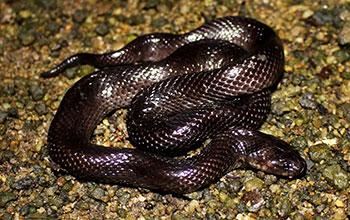Multimedia Gallery
Crab-eating water snake
A crab-eating water snake. These snakes live in giant mounds of dirt created by mud lobsters and will exit the mounds at night to forage about the floor of the mangrove forest searching for crabs to eat.
More about this image
Phil Vogrinc, a master’s student in the Department of Biological Sciences at the University of Arkansas (U of A), spent a summer in East Asia assessing how rising sea levels affect coastal, semi-aquatic snakes. Vogrinc is funded by a National Science Foundation grant that supports research for U.S. graduate students studying in East Asia and Pacific Summer Institutes (EAPSI) (grant OISE 15-15500).
According to the latest Climate Assessment Report issued by the Intergovernmental Panel on Climate Change, under the worst-case scenario, increased ocean warming and melting glaciers and ice sheets could lead to a global sea-level rise of up to 1 meter by the year 2100.
Changes such as this could be detrimental to mangrove and coastal wetland habitats, where a diverse number of species live. Singapore, which lies only 15 meters above sea level and already has lost much of its native mangrove habitat, would be particularly affected.
"Many water snakes rely on this imperiled habitat and changes in sea level could cause species extirpations," says Vogrinc. "Many of these poorly understood snakes are found nowhere else. As regulating predators in coastal ecosystems, snake losses could result in unnatural levels of some prey species, such as fish and crustaceans, and the disappearance of others--directly impacting fisheries and other economically important coastal recreational activities."
To better understand how these snakes use their habitats/ecosystems, Vogrinc searched for them in a number of locations including urban areas, such as canals, sewers and public beaches, and natural areas, like coral reefs, rocky shorelines and mangrove forests. Searching mangrove forests was particularly difficult because Vogrinc had to go at night since the snakes he studied are nocturnal. This meant traversing through knee- to waste-deep water and mud. However, it's the mud, Vogrinc says, that makes studying these snakes special. He says water snakes have evolved over millions of years in mud so many of them have very tiny eyes located on the top of their heads that allow them to view the surface of mud and water. They also have valve-like nostrils and the ability to extend their glottis into their nasal cavity to prevent salt water from entering.
While in East Asia, Vogrinc accomplished a general assessment of which snakes are found in which habitats in Singapore and why they live there.
To learn more about this research, see the U of A Research Frontiers story Surveying snakes in Singapore. (Date image taken: June 2015; date originally posted to NSF Multimedia Gallery: Oct. 4, 2016)
Credit: Phil Vogrinc, Department of Biological Sciences, University of Arkansas
See other images like this on your iPhone or iPad download NSF Science Zone on the Apple App Store.
Images and other media in the National Science Foundation Multimedia Gallery are available for use in print and electronic material by NSF employees, members of the media, university staff, teachers and the general public. All media in the gallery are intended for personal, educational and nonprofit/non-commercial use only.
Images credited to the National Science Foundation, a federal agency, are in the public domain. The images were created by employees of the United States Government as part of their official duties or prepared by contractors as "works for hire" for NSF. You may freely use NSF-credited images and, at your discretion, credit NSF with a "Courtesy: National Science Foundation" notation.
Additional information about general usage can be found in Conditions.
Also Available:
Download the high-resolution JPG version of the image. (2.6 MB)
Use your mouse to right-click (Mac users may need to Ctrl-click) the link above and choose the option that will save the file or target to your computer.

 All images in this series
All images in this series